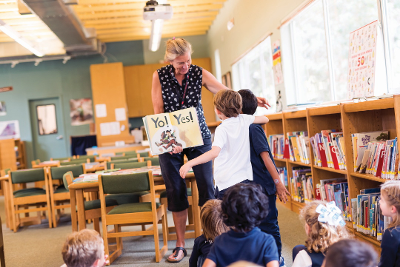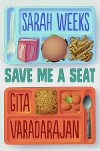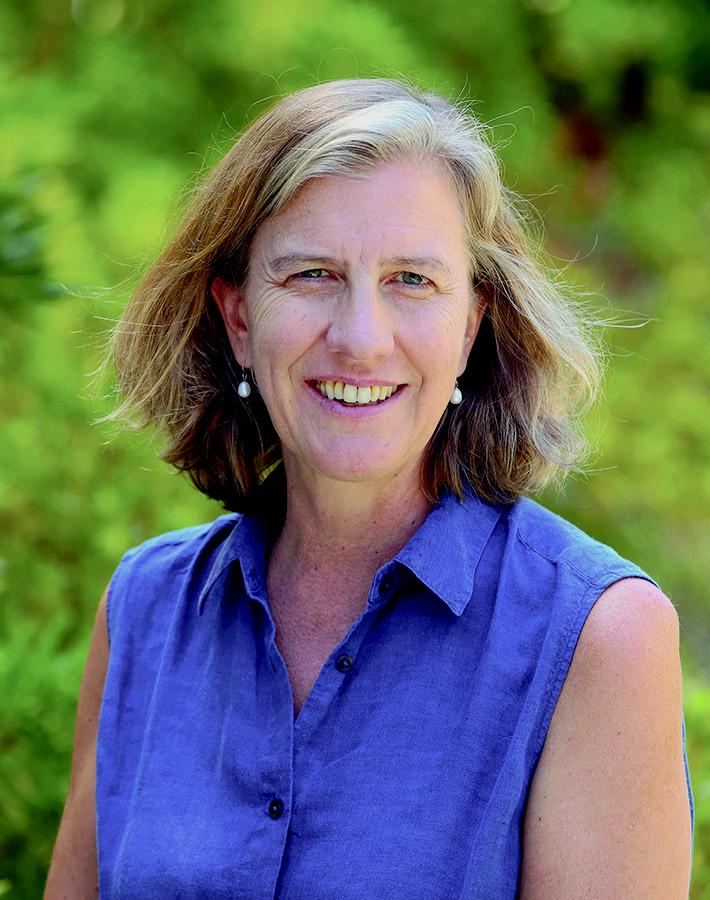Field Notes: "But Are They Level O?": Leveled Reading and Antiracism
My search began with the most ordinary of questions. All school librarians will recognize the request: a teacher sent a weekend email needing book suggestions for her fourth graders — books that were well written, accessible, and of course, engaging.

Knoth reading to a kindergarten class in her school library.
My search began with the most ordinary of questions. All school librarians will recognize the request: a teacher sent a weekend email needing book suggestions for her fourth graders — books that were well written, accessible, and of course, engaging.
The most ordinary of questions, but during the most extraordinary of years. Last spring and summer were dominated by protests over the deaths of Breonna Taylor and George Floyd. Despite our sheltering-in-place for virtually a year, COVID-19 continues to spread, and everyone is on edge. Closing borders and shutting people out is starting to seem normal. Just a few short months ago a kindergartener told me, “I don’t like the Chinese. They brought this disease to America.” If I had not already appreciated the urgency of getting diverse books into kids’ hands before, I certainly do now. It keeps me awake at night. How can I help the children at my school, an ethnically (though not economically) diverse independent school on the edge of Silicon Valley, develop the empathy they will need to dismantle the structural racism of our society? Always important, this year my responsibility to provide what Dr. Rudine Sims Bishop first called “windows” and “mirrors” for the children at my school feels especially urgent, even dire. What is my small part as an antiracist?



My first list in response to the teacher’s query included Save Me a Seat by Sarah Weeks and Gita Varadarajan, Ana María Reyes Does Not Live in a Castle by Hilda Eunice Burgos, and Clayton Byrd Goes Underground by Rita Williams-Garcia — all #OwnVoices books featuring diverse characters and perspectives; and all manageable, appealing stories for fourth graders. I offered several other suggestions as well, purposely including only books featuring children from underrepresented or systemically oppressed groups. No need to spend limited time reading about yet another middle-class white kid — not this year.
Quickly back came the teacher’s reply: “Great list, thanks. Do you know the Guided Reading Levels of these books? We are looking for O and P.” Note: Guided Reading Levels are assigned by Fountas & Pinnell using a trademarked system that considers, according to their website, “what the reader needs to be able to do at each level to read with accuracy, understanding, and fluency.” Other leveling systems include Lexile, DRA (Developmental Reading Assessment), and Reading Recovery, which use numbering or grade-related markers.
I am not a big fan of reading levels, but busy teachers often rely on them. So I set about researching which books on my list fit her readability criteria. What I found was surprising, and very disheartening. There are many places to discover excellent, engaging books that immerse readers in the experiences of the world’s children. You can look at ALA’s Notable Children’s Books lists, Coretta Scott King Book Award winners, Pura Belpré and Stonewall awardees, and more; all include books that should be on classroom shelves and tucked into desks. Books with starred reviews in The Horn Book Magazine and its peer journals represent the widest breadth of experiences of children in this country. But are the books Level O?
Finding a book’s reading level seems easy on the internet. Tools such as Scholastic’s popular Book Wizard allow the user to look up a title and find its reading level according to the various systems (and, happily, a more flexible Book Wizard appears to be under construction). Homeschool websites offer parents myriad booklists, and many public library catalogs include leveled lists as a resource for parents and teachers. Still, as I searched for the reading levels of the books I had initially recommended, I discovered either that the titles I was searching for had not been leveled at all, or that they were leveled as more difficult than my colleague needed. Of course, I can search from both directions — either check the specific level of a title I like or scan existing leveled lists for books that might suit my needs. The first method works well for librarians who have lots of great new diverse books and wonder which grade will be interested in adding a certain title to their shelves. The second works better for teachers seeking books they can hand to an individual student or reading group. And that is where I was most disappointed.
The leveled lists I found in my first hour of searching included familiar books and series like The Mouse and the Motorcycle and other classics by Beverly Cleary, Pippi Longstocking by Astrid Lindgren, and The Boxcar Children by Gertrude Chandler Warner, but few current titles, and even fewer current titles with diverse content. Yes, one favorite of mine, Clementine by Sara Pennypacker, about an intrepid girl who defies gender stereotypes, shows up on many lists, but rare was the book that featured a Latinx or Black protagonist — especially one who wasn’t, to paraphrase Jerry Craft’s Newbery acceptance speech, a victim of gang violence or a tormented kid of the civil rights era.




In the end, I was able to recommend several Level N, O, and P books (The Year of the Book by Andrea Cheng, The Lucky Stone by Lucille Clifton, Polly Diamond and the Magic Book by Alice Kuipers, and Ruby Lu, Brave and True by Lenore Look) to my colleague, and even feel good about the selections. Still, with the added layer of searching for readability, what ought to have been a simple and rewarding task had required a lot of legwork.
 I wonder how many classroom teachers are spending Sunday night scanning lists on the web and settling for The Mouse and the Motorcycle or Henry and Ribsy just because Monday is fast approaching and it’s time-consuming to ascertain that Indian Shoes by Cynthia Leitich Smith, or the Carver Chronicles series by Karen English, also meet their readability goals. Publishers are seeking out and publishing more diverse voices; white reviewers are, in my experience, expanding our own understandings by listening better to nonwhite colleagues and acknowledging the limitations of our personal experiences. As a community we are doing better at lifting up and celebrating books that widen children’s knowledge of the world, each other, and themselves. So how do we make it realistically possible for time-pressured teachers and parents using the various reading-level tools for book selection to actually find these books we are celebrating? How can I get Amina’s Voice by Hena Khan, for example, to show up when I do a quick search for level S books?
I wonder how many classroom teachers are spending Sunday night scanning lists on the web and settling for The Mouse and the Motorcycle or Henry and Ribsy just because Monday is fast approaching and it’s time-consuming to ascertain that Indian Shoes by Cynthia Leitich Smith, or the Carver Chronicles series by Karen English, also meet their readability goals. Publishers are seeking out and publishing more diverse voices; white reviewers are, in my experience, expanding our own understandings by listening better to nonwhite colleagues and acknowledging the limitations of our personal experiences. As a community we are doing better at lifting up and celebrating books that widen children’s knowledge of the world, each other, and themselves. So how do we make it realistically possible for time-pressured teachers and parents using the various reading-level tools for book selection to actually find these books we are celebrating? How can I get Amina’s Voice by Hena Khan, for example, to show up when I do a quick search for level S books?
In our current educational climate, readability ratings are one more obstacle to getting books into the hands of young readers. Knowing that, once I find the reading level of a book deserving attention, I can spread the word by heading over to Goodreads and adding titles to existing leveled lists. I can make comments on blogs, suggesting favorite new diverse titles and including their reading levels. I can nudge my public librarian colleagues to update the lists they post on BiblioCommons and other such sites. With some social media savvy, we can tag current books with their reading levels. With enough mentions, a simple Google search will turn up these amazing choices, matched already with level information.
Want to join me? Together, if we make a concerted effort, we can make real progress.
From the March/April 2021 issue of The Horn Book Magazine.

RELATED
ALREADY A SUBSCRIBER? LOG IN
We are currently offering this content for free. Sign up now to activate your personal profile, where you can save articles for future viewing.







Add Comment :-
Comment Policy:
Comment should not be empty !!!
Lisa Blount
Thank you so much for this relevant post and amplifying the need for more diverse stories at every level of reading. I am an elementary school librarian and run into the same problem. We use Renaissance's Accelerated Reader system, though I am not always a fan of this system. I appreciate the titles you listed, we have a few of them already and now I can recommend them to teachers searching for books at this level.Posted : Apr 12, 2021 04:42
Eric C
You could have just told the teacher that the books you originally selected were O.Posted : Apr 01, 2021 03:57